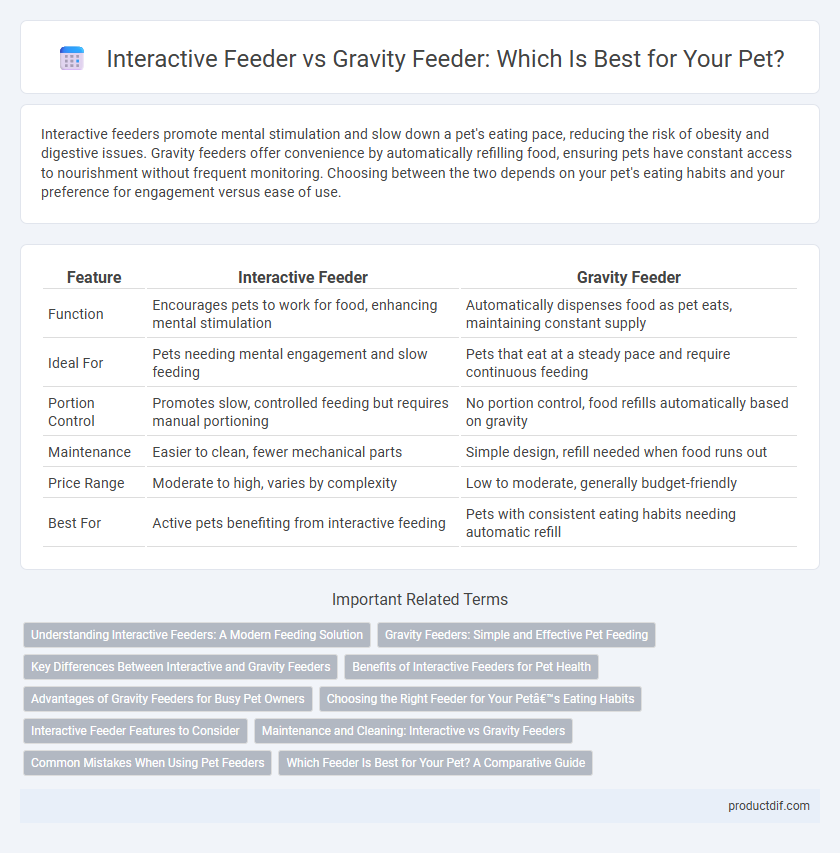Interactive feeders promote mental stimulation and slow down a pet's eating pace, reducing the risk of obesity and digestive issues. Gravity feeders offer convenience by automatically refilling food, ensuring pets have constant access to nourishment without frequent monitoring. Choosing between the two depends on your pet's eating habits and your preference for engagement versus ease of use.
Table of Comparison
| Feature | Interactive Feeder | Gravity Feeder |
|---|---|---|
| Function | Encourages pets to work for food, enhancing mental stimulation | Automatically dispenses food as pet eats, maintaining constant supply |
| Ideal For | Pets needing mental engagement and slow feeding | Pets that eat at a steady pace and require continuous feeding |
| Portion Control | Promotes slow, controlled feeding but requires manual portioning | No portion control, food refills automatically based on gravity |
| Maintenance | Easier to clean, fewer mechanical parts | Simple design, refill needed when food runs out |
| Price Range | Moderate to high, varies by complexity | Low to moderate, generally budget-friendly |
| Best For | Active pets benefiting from interactive feeding | Pets with consistent eating habits needing automatic refill |
Understanding Interactive Feeders: A Modern Feeding Solution
Interactive feeders encourage pets to engage actively with their mealtime, promoting mental stimulation and slowing down eating pace to improve digestion. Unlike gravity feeders that provide constant access to food, interactive feeders require pets to solve puzzles or manipulate components to release kibble, making feeding a more enriching experience. This modern solution is especially beneficial for pets prone to overeating or boredom, supporting healthier habits and enhanced cognitive function.
Gravity Feeders: Simple and Effective Pet Feeding
Gravity feeders provide a reliable, no-fuss solution for pet owners seeking consistent meal portions with minimal oversight. Designed to dispense food automatically as pets eat, these feeders maintain a steady supply of dry kibble, reducing the risk of overfeeding or hunger between meals. Their simplicity and durability make gravity feeders a cost-effective choice for ensuring pets have access to food throughout the day without complex programming or electronic components.
Key Differences Between Interactive and Gravity Feeders
Interactive feeders stimulate pets mentally and physically by requiring them to work for their food, promoting engagement and reducing boredom. Gravity feeders provide a continuous supply of food by automatically refilling the bowl as the pet eats, ensuring constant access without effort. The key difference lies in the level of mental stimulation and control over portion sizes, with interactive feeders encouraging activity and gravity feeders supporting free feeding.
Benefits of Interactive Feeders for Pet Health
Interactive feeders promote slower eating, reducing the risk of obesity and digestive issues in pets by encouraging natural foraging behavior. They provide mental stimulation, which helps alleviate boredom and anxiety, leading to improved overall well-being. Unlike gravity feeders, interactive feeders actively engage pets in problem-solving, enhancing cognitive function and supporting healthier eating habits.
Advantages of Gravity Feeders for Busy Pet Owners
Gravity feeders provide a consistent and effortless feeding solution for busy pet owners, ensuring pets have access to food throughout the day without constant supervision. These feeders reduce the risk of overfeeding and food spoilage by dispensing portions based on gravity, which is especially beneficial for pets with regular eating habits. Their simple design minimizes maintenance and refilling frequency, allowing pet owners to focus on other responsibilities while pets remain well-nourished.
Choosing the Right Feeder for Your Pet’s Eating Habits
Interactive feeders engage pets by providing mental stimulation and slowing down their eating pace, ideal for pets prone to overeating or boredom. Gravity feeders offer a continuous food supply, suitable for pets with consistent eating habits or those left alone for extended periods. Selecting the right feeder depends on your pet's activity level, eating speed, and daily routine to promote healthy digestion and prevent obesity.
Interactive Feeder Features to Consider
Interactive feeders for pets often include features such as adjustable puzzle difficulty levels, durable chew-resistant materials, and non-slip bases to prevent tipping. These feeders stimulate pets mentally and encourage slower eating, which can help reduce overeating and digestive issues. Compared to gravity feeders, interactive models offer more engagement through challenges that promote natural foraging behavior and provide enrichment.
Maintenance and Cleaning: Interactive vs Gravity Feeders
Interactive feeders require more frequent cleaning due to moving parts that can trap food residues and bacteria, ensuring pets stay healthy. Gravity feeders have simpler designs with fewer components, making maintenance quicker and less demanding. Regular cleaning of both feeder types is essential to prevent mold growth and ensure safe feeding conditions for pets.
Common Mistakes When Using Pet Feeders
Common mistakes with interactive feeders include selecting complex puzzles that frustrate pets, leading to decreased food intake and increased stress. Gravity feeders often cause overfeeding or food contamination if not regularly cleaned and monitored, as they dispense food continuously without portion control. Both types require proper adjustment to pet size and behavior to prevent health issues such as obesity or malnutrition.
Which Feeder Is Best for Your Pet? A Comparative Guide
Interactive feeders stimulate pets mentally and physically by requiring problem-solving skills to access food, helping to slow down eating and prevent obesity. Gravity feeders offer convenience with automatic food replenishment, ideal for pets with consistent eating habits but may encourage overeating. Choosing between interactive and gravity feeders depends on your pet's behavior, feeding needs, and your lifestyle to ensure optimal health and engagement.
Interactive Feeder vs Gravity Feeder Infographic

 productdif.com
productdif.com